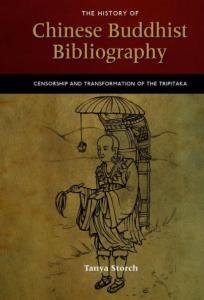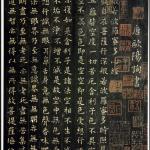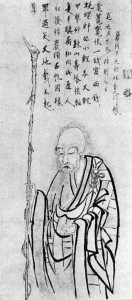
Katagiri Roshi, who spent most of his life sitting zazen and studying, said that the point of studying was to discover how stupid we are.
I’d add that through familiarization with the subtlety and vastness of the dharma, study deepens our appreciation for this tradition. Study of primary sources, especially, helps to go beyond what might be trendy and superficial in our contemporary dharma scene. Another reason to immerse ourselves in study is to get a glimpse of the buddhadharma through another lens, to the extent possible, of an earlier generation in very different cultural circumstances as they too wrestled with the issue of authenticity, or “what is the true buddhadharma?”
This helps us to see our own perspective and to accept our profound stupidity. So it’s a great antidote to dogmatism. And I also just find it really fun.
Tanya Storch takes this up (what is the true buddhadharma and how did the ancient Chinese wrestle with the issue?) in The History of Chinese Buddhist Bibliography: Censorship and Transformation of the Tripitaka. The title might lead you to think that this is quite a niche-market book. And I suppose it is. However, it is one of the clearest, easy-reading, and engaging books by a Buddhist scholar that I’ve ever read. I give Storch two thumbs up and a strong recommendation, especially if you find yourself in the the dharma wonk demographic of about 5,000 people on the planet. Or less.
Why did the ancient Chinese get into sutra bibliographies?
The story begins (to loosely paraphrase Storch) couple thousand years ago. The Chinese were getting interested in the buddhadharma and began to get acquainted through monks that traveled to China from the south and west, as well as Chinese pilgrims that took the reverse journey. These monks, both the foreign monks and indigenous Chinese upon return, brought with them texts that they had memorized – seldom, apparently, were they working from anything written down. And in any case, there was no Sanskrit Canon, just a large collection (thousands) of texts and commentaries. So the travelling transmitters of the buddhadharma would sit with a committee and recite sutras and others would translate the Sanskrit into oral and written Chinese.
Then others would copy the sutra by hand, because this was hundreds of years before woodblock printing got going. So as time ticked along, a whole bunch of sutras and the simultaneously created commentaries, varying a great deal in style and content, started to spread around. For seekers of the way who pursued a foreign religion in a land where Confucianism and Daoism were well-established, a list of authentic texts became really important. This was also important and for those trying to establish the credibility of the buddhadharma for political reasons. Often, of course, these two groups had considerable overlap.
Within the collection of translated texts, there were many different, sometimes contradictory, teachings. Small vehicle, great vehicle, diamond vehicle. Precepts, teachings, and analysis. Which were authentic? Complicating matters, many of the texts came to be in questionable circumstances. Storch writes,
“As a result of the emphasis on the written dimension of the canon, production of Buddhist manuscripts began to extend and flourish across Central Asia, especially in the Gansu corridor, one of the main areas through which Buddhism traveled to China. Production of Buddhist manuscripts in the areas located near the Silk Road was stimulated by Chinese religious pilgrims who zealously searched for them and were willing to travel a thousand miles from home just to obtain one new text. Buying and selling these manuscripts became a booming business, and many territories west of China became centers for the production of forgeries.”
Standard for authenticity
When you have a large group of teachings with different messages, how are you going to judge what’s the real deal? What the early compilers of bibliographies determined was the standard for authenticity, following Confucian textual analysis, was not the “truth” or verifiability of the teaching of a particular sutra, but who the translator was and when/where it was translated. In part, this choice was due to the high regard for translators in ancient Chinese culture (see below) and because it mirrored the process in Confucianism and thus gave the buddhadharma equal status.
There are problems with that standard, though. First, most of the early translations were done anonymously so the compiler had to figure out who might have done it. There was little historical data and little sophistication, from a modern perspective, so the style of the text became the main standard. Storch notes that
“The situation is remarkably similar to the way the New Testament canon was created; that is, for Christians, the criteria were found in associating texts with a known and trusted apostle. But when this criterion was applied to the writings extant at the time, false attributions arose en masse. The number of these invented attributions is stunningly high for a canon as small as the New Testament. Out of nearly thirty books, fewer than a dozen can be reliably demonstrated today to be the work of the author named in the titles. One should think, therefore, that the Chinese Buddhist canon would not be immune from similar—and numerous—cases of invented attributions.”
In addition to questions about the translator, there were a couple ways that a sutra could easily find itself in the “suspect or false” category. First, if the sutra advanced messianic/apocalyptic teachings, these were thought to have an unsettling effect on the status quo, apparently from perspectives of both the sangha and the emperor, so these texts were generally labeled as fake. This is quite different from how such teachings were regarded in Europe, where they were used for political and religious gain by the clergy and politicians. Regardless of the Chinese bibliographers opinions, though, messianic/apocalyptic teachings continued to be popular.
In addition, if a text came from the “many territories west of China [that] became centers for the production of forgeries,” it was determined to be suspect or false, without consideration of the content. It seems that a lot of creative buddhadharma might have gotten the boot in this way.
Finally, the bibliographers, funded by the emperor, often using the imperial library, sorted the bibliographies to appeal to the ruling elite, of which they were usually members. So, according to Storch, what we have today as the Chinese Buddhist Canon has gone through a long process of transformation and censorship.
Translator status
It’s important to note that translators were also transmitters, bringing the dharma to China. As such, they were very highly regarded, but perhaps more for their supernatural abilities than scholarly skills or dharmic clarity. Their stories are filled with magical feats. Storch writes,
“In Huijiao’s collection [of translators biographies], out of thirty-four translators’ biographies, miracle performing is encountered in twenty-one. In certain biographies, the supernatural narrative is so dominant that only a small portion of the biography somehow pertains to the translation of Buddhist texts, while the rest of it reads just like a typical hagiographical account would; that is, one supernatural episode follows another. A good example of this is the biography of Kumarajiva (350–413?), in which less than 10 percent of the entire text pertains to his translations, and the rest relates a life filled with all sorts of miraculous events.”
Moreover, translators were regarded as top-shelf monks.
“Huijiao’s classification ranked monks in the following order: (1) translators (yijing), (2) exegetes (yijie), (3) divine wonders (shenyi), (4) practitioners of meditation (xichan), (5) elucidators of the regulations (minglu), (6) those who sacrificed themselves (wangshen),7 (7) chanters of scriptures (songjing), (8) benefactors (xingfu), (9) hymnodists (jingshi), and (10) proselytizers (changdao).”
This classification was adopted, with some additions and subtractions, but it seems that the ranking of meditators didn’t change much, at least in ancient China.
The role of supernatural powers was huge in the old world. Buddhism may have been successful in China largely due such things. Storch writes,
“Buddhist historians have repeatedly underscored the advantage that the monks had over Confucian scholars—namely, their ability to provide help by using magic, not only by speaking and doing what was morally right. But ultimately, of course, both aspects were crucial for introducing the monks’ images into Chinese culture, and possibly it was because supernatural healing and magical protection constituted strengths that Confucian scholars did not have that the early biographies focused on them somewhat more than on their subjects’ scholastic qualities.”
Where does that leave us?
In short, not depending on words and letters. What the buddhadharma offers is a direct experience of the insights of the Buddha, not a belief system ensconced in dead words. Wrangling about what the Buddha said and didn’t often gets down to sectarian bickering. As Linda Heuman put it in “Whose Buddhism is Truest,”
“When it comes right down to it, sectarian posturing contradicts the Buddha’s message as all traditions understand it. Those false pictures of history and language within which sectarianism finds a foothold are in turn rooted in another false picture—a picture even more pervasive and pernicious. That picture is an essentialist view of the nature of reality, which according to the Buddha’s doctrine of selflessness is the source of not just this but all our suffering—the wrong view that is the very point of Buddhism to refute.”












